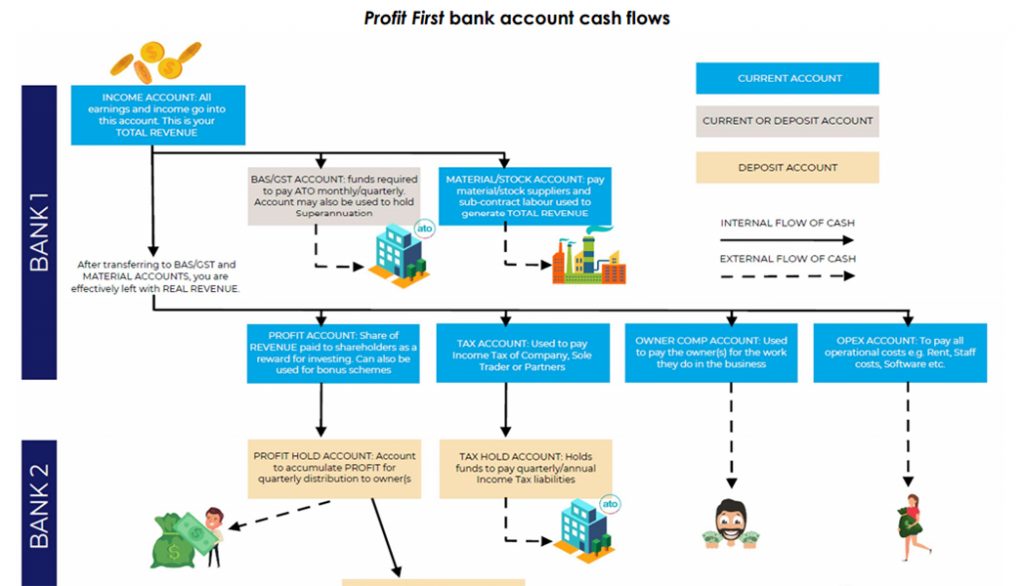Profit First Bank Accounts & Cash Flow
For those who need or prefer the written word to watching a video, I’ve written a transcript of the above video. It’s an easy to understand breakdown of what each bank account is for and how to use it. If you need a more permanent visual aid, please download the PDF flow chart shown in the video at the end of this article.
Hi, this is Ian from Refresh Accounting.
Thank you for tuning in to watch this video, in which we explain the flow of funds through your Profit First bank accounts, using this diagram which you can download from our website.
If you’ve read the book Profit First by Mike Michalowicz you’ll be familiar with the concept of using a number of bank accounts to bring clarity to the cash position of your business. If you’re new to Profit First and thinking ‘how many accounts!’, please read our article ‘What Is Profit First? (An Overview)’, download the first two chapters of the book free from our website or, of course, you can buy the book from your local or online bookshop, to get a more in-depth understanding of why using multiple bank accounts can get you and your business on the path to permanent profitability – where profitability means actual quarterly dividends to business owners to reward them for investing in their business.
So, for the purpose of this presentation, we’ll assume the book has been read, or you have a working knowledge of Profit First. We’re also assuming that you’re a visual person, many people are and that’s why we developed this diagram for our clients so that they can print it out and stick it on their wall next to their computers, as a quick reference guide to the flow of funds and the purpose of each account.
To keep things simple, we have only included the Profit First accounts that most businesses start with. Not every business needs all these accounts and some business will benefit from having more.
The PDF Download Explained…
The bank accounts are the coloured boxes and have been colour-coded to differentiate between those that we recommend being set up as a current or transaction account, for example, the INCOME account, those that we recommend are deposit or savings accounts, like the PROFIT HOLD account here, and those where they can be either, like the GST account. As I say, recommendations, not ‘must-dos’!
In addition to colour-coding the bank accounts we have shown the internal flow of funds in a solid line, whereas when funds leave your business they are shown as a dashed line.
Profit First recommends that you use two different banks. Why two different banks? You use bank 1 accounts for day-to-day transactions, bank 2 accounts are where you put your funds that you are saving and will access infrequently. Out of sight, out of mind. So, on the left-hand side of the diagram, you will see two boxes called Bank 1 and Bank 2. The bank location for each of the recommended Profit First accounts are shown to the right of each Bank. For example, you will see Income and OPEX to the right of box Bank 1 and PROFIT HOLD to the right of the box Bank 2.
Profit First Bank Accounts Summary
Now, let’s run through the purpose of each account and the flow of funds, starting at the top and working our way down and across the page in the order that you will allocate your funds.
INCOME – this is the account that all your revenue is paid into and from which you allocate funds to all the other accounts based on your business allocation percentages. You don’t pay anything out of this account, except to your other accounts;
BAS/GST – If you’re not registered for GST then you will not need this account. If you are then transfer your GST allocation into this account. Some businesses will also transfer WET and Excise Duties received into this account too. We also recommend that you transfer PAYG deducted from wages to this account from your OPEX account when you pay wages. We allocate to this account first because none of the cash in this account is yours, it belongs to the government and we don’t want to be in the position of owing them;
MATERIAL/STOCK – If you pay more than 25% of your income to suppliers of materials or sub-contractors for products and services that you sell, then it is recommended that you have a separate account for these suppliers. If you don’t pay more than 25% then you will not need this account. We allocate to this account second because if we can’t buy the goods or services that we resell then we don’t have a business.
Once we have allocated to our BAS and Material accounts, we are left with our real revenue. This is what we have to run our businesses on. Now we can start allocating to the rest of the accounts.
PROFIT – This is the account that we allocate our profit percentage to. As mentioned previously, Profit is cash that will be paid to the business owner as a quarterly dividend to reward you for investing in your business. You can see in the diagram that there are two Profit accounts. The first in bank 1 and then Profit Hold in bank 2. In my business I use both accounts, firstly transferring to the Profit account from my Income account and then transferring the same amount to my Profit Hold account in bank 2. There are some businesses that prefer to miss out the Profit account and transfer straight to the Profit Hold account. Choose whichever way is best for you;
TAX – Transfer to this account the percentage allocation required to pay tax on the business profits. As with the Profit accounts, there are two Tax accounts, one in bank 1 and the Hold account in bank 2. Again, choose whichever option works for you;
OWNER COMPENSATION – We transfer to this account the percentage of income that we have allocated that rewards the business owner for the work that they perform for their business. Owner Compensation includes wages paid to the owner together with other expenditure that the owner benefits from, for example, personal car costs, health insurance etc. You either pay those amounts out of the Owner Compensation account or you can transfer it into your OPEX account if it is easier to pay everything out of that account, for example, if you’re paying wages as a payroll run.
OPEX or Operational Expenses – From this account, you will pay wages, rent, rates and all the other administrative costs associated with running your business. By making this the last account that we allocate to, we have created a business where you have been rewarded for your business investment (Profit), your work in the business (Owner Comp), you have bought the goods and services that you resell (Material) and covered your tax liabilities (Tax and GST). If you can then run your business on what is left, you have a permanently profitable business.
The last 3 accounts on the diagram are all at bank 2. PROFIT HOLD, TAX HOLD and VAULT.
PROFIT HOLD – Is used to accumulate business profit for distribution to the owners. A distribution occurs once per quarter, usually at the end of March, June, September and December. It is recommended that you distribute half of the funds that have been accumulated in the Profit Hold account, with the other half either staying in the account or being transferred to the Vault account.
TAX HOLD – aIs used to accumulate funds to pay tax on the profits of the business. Transfer from this account to the account that you will pay your quarterly taxes from.
VAULT – As I have said, you transfer to this account from the Profit Hold account 50% of the funds accumulated in the Profit Hold account each quarter. The initial aim of this account is to have sufficient funds to run the business for 3 months in the event of a significant negative event, such as, as we have all experienced, a pandemic. Once you have 3 months of expenditure saved, you can then continue to save so that you can take advantage of any business situations that may arise, such as expansions, new equipment etc.
If you’re not sure which accounts you need or whether you need different accounts please book a call!
At Refresh Accounting, we know that business owners are stressed by cash flow and a lack of time to enjoy their life. This leads to burnout, business failure and relationship issues. By implementing our systems and tools, small business owners will have money in the bank, and the time to spend doing the things that they love like playing with their kids or taking the weekend off to go camping. Book a call now and we’ll help you develop a business that is permanently profitable and meets your lifestyle needs.
Thank you for watching.
If you’d like more information, read our full article on Profit First accounting next!


